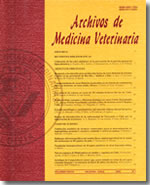Contenido de glicosaminoglicanos del líquido sinovial de la articulación metacarpofalángica de caballos castrados y yeguas de diferentes edades
Contenido principal del artículo
Resumen
Se midió la concentración de glicosaminoglicanos (GAGs) del líquido sinovial en su valor total (GAGsT) y de una fracción de éstos, que corresponde a los GAGs diferentes del ácido hialurónico o GAGs sulfatados (GAGsS), entre los que se describen condroitin sulfato y queratán sulfato. Las muestras de líquido sinovial se obtuvieron por artrocéntesis aséptica desde articulaciones metacarpofalángicas normales de equinos mestizos en matadero, después del beneficio de los animales. El exámen post mortem de las articulaciones permitió descartar articulaciones con evidencias de osteoartritis u otras patologías articulares. La normalidad del líquido sinovial se evaluó por de su aspecto y por las pruebas del coágulo de mucina y de concentración de proteínas (<15mg/ml). Se escogieron 4 grupos de edad que se dividieron a su vez, en yeguas (y.) y caballos castrados (c.c.), de la siguiente forma: 1,5 – 2 años (n = 23: 12 y. y 11 c.c.; 4 – 5 años (n = 15: 9 y. y 6 c.c.); 6 – 8 años (n = 23: 13 y. y 10 c.c.) y sobre 10 años de edad (n = 17: 12 y. y 5 c.c.). Para cuantificar los GAGs se utilizó un método colorimétrico con Alcian Blue usando diferentes concentraciones de MgCl2.
Al comparar la concentración de GAGsT entre yeguas y caballos castrados, no se encontraron diferencias significativas. Sin embargo, al analizar el promedio del grupo mayor de 10 años de ambos sexos (1.71 ± 0.79 mg/ml), éste fue inferior (p < 0.05) con respecto al grupo de 6 a 8 años (3.39 ± 1.93 mg/ml). El contenido de GAGsS, que refleja la actividad catabólica de la MEC del cartílago, no mostró diferencias entre yeguas y caballos castrados en cada grupo de edad. Sin embargo, el promedio de estos GAGsS fue mayor (p < 0.05) en los caballos castrados (0.48 ± 0.28 mg/ml) que en las yeguas (0.34 ± 0.15 mg/ml) y tienden a disminuir a través de la edad en ambos grupos. La diferencia entre los GAGsT y los GAGsS, permitió estimar el contenido de ácido hialurónico del líquido sinovial, cuyo perfil fue semejante al de los GAGsT. Su concentración fue menor en el grupo de mayor edad de yeguas (1.62 ± 0.76 mg/ml) y de caballos castrados (0.96 ± 0.64 mg/ml).
Estos resultados apoyan la influencia de la edad y de la condición de sexo sobre la concentración de GAGs en el líquido sinovial, lo que podría reflejar la condición metabólica de los componentes articulares y que podría ser útil para la comparación con las patologías articulares.

